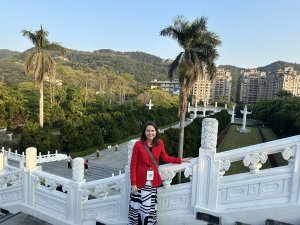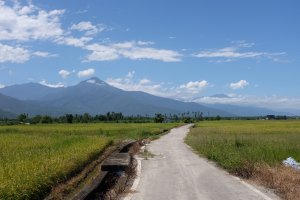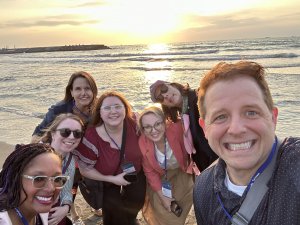I was very fortunate to have the opportunity to be a senior research scholar working on a cross-strait research project in Taiwan and Mainland China. The World Health Organization (WHO) has designated childhood obesity as a global epidemic and a major public health issue. Overweight is defined as a body mass index (BMI) at or above the 85th percentile and below the 95th percentile for children and teens of the same age and sex. Obesity is defined as a BMI at or above the 95th percentile for children and teens of the same age and sex. For adults, overweight is defined as a BMI of 24 to 27.99 and obesity is a BMI of 28 or higher.
The prevalence of childhood obesity is growing fast in many developing countries, including Taiwan. Given that obesity at preschool age is associated with young adulthood obesity and young adulthood obesity is associated with adverse cardio-metabolic psychosocial outcomes, preschool years are a critically important period for developing healthy lifestyles and preventing childhood obesity. As a global health nursing researcher, this opportunity to stay in Taiwan to understand how familial and environmental factors contribute to the global obesity epidemic is one of the best investments I have ever made. I also brought my two children with me, so this experience not only impacted me but also my children’s lives.
I started my Fulbright in mid January and stayed in Taiwan for four months. My host institution, National Defense Medical Center, was very helpful in helping me to identify potential preschools where I would be able to collect data. My host institution also provided me an office where I can work with students and faculty. In less than 3 months we have recruited about 185 pre-school age children and their mothers to participate in our study. I worked with 5 preschools in Taipei and Kaohsiung. I have measured more than 500 children’s weight, height and waist circumference as part of the service I provided when working with these preschools.
I often had lunch with kids and teachers when I visited these schools and had the opportunity to observe a preschooler’s daily life in Taiwan. In addition to asking mothers of the preschool-age children to complete a set of survey questions related to their dietary habits, physical activity patterns and parenting style, I interviewed several mothers about their perceptions of the challenges of being a mother. Because I am also a mother, these mothers and I can connect easily, especially when dealing with children’s issues. I can also relate to their comments easily. These interactions with children, teachers and mothers provided valuable information related to the data I have collected. I am truly grateful for their time and willingness to share information with me.
During my stay in Taiwan I had discussions with my colleagues in Taiwan about the preliminary findings. The overweight prevalence was 14.1%, 36.4% and 58.3% for child, mother, and father, respectively. The obesity prevalence was 9.8%, 6.9% and 23.8% for child, mother, and father, respectively. About 20% of mothers and 74% of fathers had a waist circumference greater than the recommended level. In this study, we also found that three factors associated with increased body mass index in preschool-age children were maternal beliefs in the child’s proneness to obesity, the gender of the child being female, and more unhealthy food stimulus exposure at home.
My colleagues and I were not surprised by the high prevalence of overweight and obese fathers, but were surprised by the higher prevalence among preschool-age children. Many interesting discussions and hypotheses were made at lunchtime and at lectures I gave. My colleagues and mothers of preschool-age children provided me with helpful insights on reasons for increased prevalence of obesity for children and explanations of the differences in education and environment and their role in the development of obesity and even type 2 diabetes mellitus. Because I was able to spend a significant amount of time with these preschoolers, I was able to explain the impact of environment on their health.
In addition to spending time in many preschools, I was also able to spend more time with my two children who attended an international school in Taipei. Because I was born in Taiwan and spent my first 19 years there I had no language barrier when it came to communication. My children who are half Taiwanese and half Indian living in the U.S. had the opportunity to go to school in Taiwan to not only learn basic subjects but also improve their Mandarin. Although they can speak some Mandarin, the 4 months of stay gave them an opportunity to practice and also gain an appreciation of Mandarin.
Because of their schooling, I spent some time with their new friends in Taiwan and learned from them about what elementary school life is like. I got to know many of their friends’ parents which helped me to understand the educational and health care system in Taiwan. We had many discussions on how the system impacts a child’s development in both physical and psychosocial domains. We shared information on how the systems in the U.S. and Taiwan are similar and yet very different in many ways. Many of these discussions happened at play dates and school pick-up time. As a global health conscious citizen, living in another country and experiencing the difference in the society brings clarity to many puzzles in data we have collected.
In addition to my research work, I taught a graduate course at the National Defense Medical Center’s School of Nursing and gave several guest lectures in Kaohsiung Medical University’s School of Nursing. Although I have published more than 40 scientific papers, I had never taught students how to publish, so this was a very interesting course for me to teach. Students and I got to know each other well since we spent about 2 hours per week working on their manuscripts. I think the message they got from me is “Never give up” and “Think outside of the box”. These courses were taught in English and because I can communicate in both Mandarin and English, students felt comfortable talking to me in Mandarin, especially when they got stuck on a word or terminology.
I enjoy teaching in Taiwan as the respect you get is different from the respect you receive here in the U.S. Besides teaching a formal course, I also gave lectures on various topics in different universities in Taiwan. These topics included research methodology, career pathways, and the U.S. nursing education system. Bringing the most up-to-date research methodology and insider knowledge of the US nursing education system to Taiwan helped my colleagues and students understand nursing research and the nursing profession in the U.S. I also learned from them about nursing research and the nursing profession in Taiwan. These exchanges are key to the collaboration and improvement of nursing practice and nursing research.
Although I was based in Taipei, I had the opportunity to teach at Kaohsiung Medical University. Because my children also came with me to Taiwan, they got to see me in ACTION. They sat in on some of my lectures/talks and helped me with data collection in one preschool. I think they finally realized that I have a very demanding yet interesting profession. They also think I talk a lot, yet listen most of the time. I also got to spend more time with them as the school day ended at 3:30pm every day.
I got to see how my children played with other kids at school in the playground and answered many children’s questions on what the U.S. is like, why my children can speak both Mandarin and English, and why they don’t look Chinese. Listening to how my children responded to these questions from their classmates (elementary school) reminded me of the development of self-identify and curiosity in children. Because I got to spend more time with them in Taiwan, I feel I know them at a different level.
In addition to work, I also had very interesting life experiences in Taiwan. We experienced snow in Taiwan (during the Fulbright mid-year conference) and an earthquake before Chinese New Year. Living in Northern California, snow is not common so we were super excited to see snow in Taiwan, as this is a place we would not expect snow. During the first week of our arrival in Taiwan we got to meet other Fulbright fellows and their families. This is extremely important to us as the children felt that they were not alone and there were other children from the U.S. We made friends with some families and this was a great beginning to my Fulbright program as it made the transition much easier for us.
The other big event that happened is the earthquake. The earthquake in Taiwan was a very unfortunate and devastating event but it also highlighted how the Taiwanese were eager to help each other in such an event. This was a good example for me to use in order to discuss disaster preparation and safely issues with my children. Most importantly, I got to spend Chinese New Year with my parents in Kaohsiung and my children received their first “red envelope” in Taiwan. Moreover, we got to go to the Science Museum, Taipei Zoo, the hot spring in Beitou, many night markets and Hualien for three days.
Looking back on what I have accomplished in Taiwan, here are my highlights:
-
– Collected both quantitative and qualitative data related to risk for childhood obesity among preschool-age children (n=185)
-
– Provided weight and height assessment to more than 500 preschool-age children.
-
– Taught 1 formal graduate course at National Defense Medical University
-
– Gave three guest lectures to international students at Kaohsiung Medical University
-
– Gave 5 presentations related to research methodology and US nursing education system to students and faculty at three different universities
-
– Spent at least 7 hours per day with my children when they were awake and not at school.
-
– Visited Hualien and many local attractions in Taipei including several night markets.
This wonderful Fulbright experience not only advances my academic and professional development but it also improves my relationship with my family. I am very grateful to have had the opportunity to be a Fulbright Scholar in one of the friendliest and tech savvy countries, Taiwan!
Post Views: 5,069





